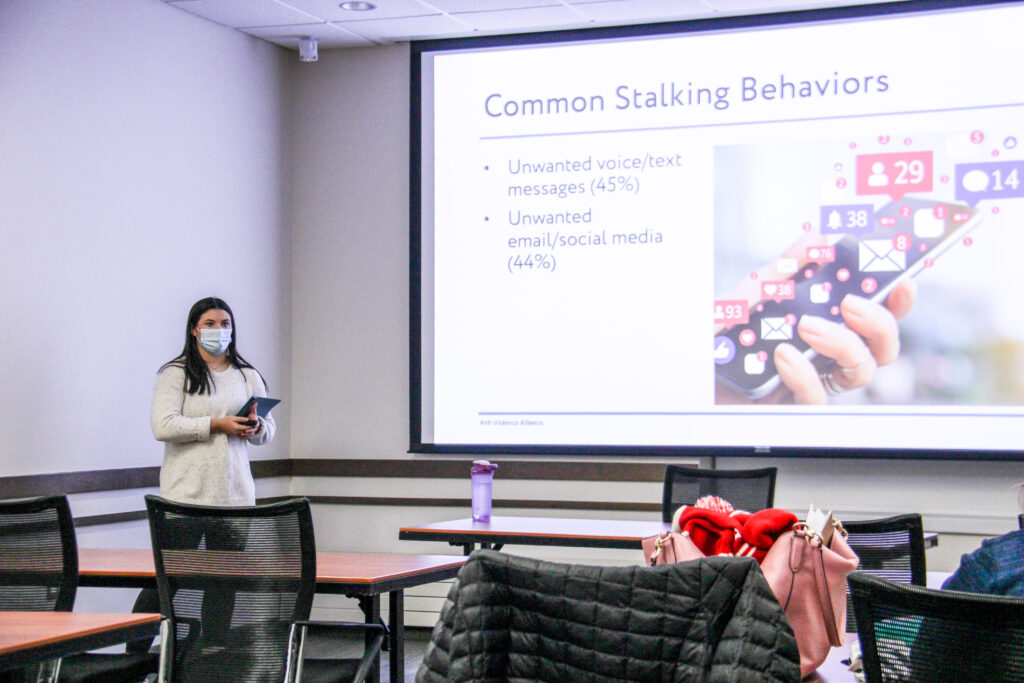
Critical information about cyberstalking and harassment was presented to Ferris students Thursday evening.
The presentation was organized by the Anti Violence Alliance at Ferris State. The AVA covered signs of stalking, statistics and resources for individuals who were or are victims of stalking. Below is some of the important information that was provided.
Stalking Behaviors
Individuals can experience stalking in many ways. Constant texts and phone calls, driving past an individual’s house and monitoring an individual’s location can all be stalking behaviors when unwanted and persistent. Individuals may also show up at locations the victim does not want them at or seek them out in everyday life.
Stalking can also take place online. Social media has provided more options for stalking and harassment to take place. Perpetrators of stalking may create fake social media profiles to gain access to the victim’s private accounts or to pose as the victim. They may also share intimate images of the victim online without the victim’s consent.
The perpetrator may also use the internet to gain access to the victim’s personal devices. Spyware can be installed onto phones and computers to track the victim’s location, texts, phone calls and to gain access to the device’s camera and microphone. The perpetrator can also dox the individual, finding and publishing personal information about the victim.
The AVA’s presentation stated that 45% of stalking incidents reported by college campuses involved unwanted texts and voice messages. 44% involved unwanted emails and social media interaction. Doxing was involved in 16% of the incidents.
Victims and Perpetrators
Anyone can be a victim of stalking. According to the presentation, stalkers are usually known to the victim, typically a former or current intimate partner. Individuals 18-24 years of age experience the highest rate of stalking among adults.
The AVA reports that 1-in-4 women and 1-in-17 men are victims of stalking. According to a 2018 campus survey conducted by Ferris, 28.8% of students reported being victims of stalking behavior.
What to do
Individuals who are told about stalking behaviors by a friend or someone close to them should be supportive of the individual. Providing a safe place for the individual to discuss the behaviors can help the victim feel safe and comfortable. They should provide resources to the victim if they have access to them.
Bystanders who witness stalking behavior can use the five D’s of bystander intervention, according to the AVA. The five D’s are distract, delegate, direct, document and delay. The AVA says that direct, document and delay are the most useful when handling stalking behaviors.
For direct, the bystander or victim could directly block the perpetrator on social media or tell the perpetrator to leave them alone if they are comfortable doing so. For document, the bystander or victim could take screenshots of the persistent texts or phone calls they receive. They could also document the date and time the different incidents occur. For delay, the bystander can check on the victim after the incident.
Resources
There are many resources available to victims of stalking. On campus, there is the Title IX Office, the Personal Counseling Center, the AVA website and the Office on Violence Against Women. The Title IX Office and the OVW are not confidential, meaning that the incidents discussed would be reported to the proper authorities if required.
Title IX Office: ka*********@****is.edu OR (231) 591- 2088
PCC: Th****@****is.edu
Anti-Violence Alliance: fsuantiviolence.org
OVW Project Director: ra********@****is.edu
